Are you unsure which wheel to use for grinding tungsten carbide? Choosing the wrong abrasive can destroy your tool and your workpiece. The green wheel in your inventory has a very specific, and valuable, purpose.
A green silicon carbide grinding wheel is a precision grinding tool made from high-purity silicon carbide. Its main characteristic is being very hard and highly friable, making it the ideal choice for grinding extremely hard and brittle materials.
![]()
In our factory, we produce a wide variety of abrasive products1, and silicon carbide wheels are a key part of that lineup. Some customers ask why certain wheels are green. The truth is, the green color is often a pigment we add during manufacturing. We do this for a couple of important reasons. First, it looks good, but more importantly, it provides a clear visual identity for the wheel. On a busy shop floor, an operator can immediately recognize it as the go-to tool for specific hard materials. The color also provides a nice contrast against the workpiece, making it easier for the operator to see the wheel’s wear and know when it’s time for a replacement.
What is green silicon carbide used for?
You have this sharp, green wheel, but what is its best use? Using it for a general-purpose steel job would be a serious mistake. To get value from this tool, you must use it on the right materials.
Green silicon carbide is used for grinding the hardest and most brittle materials. Its primary applications include sharpening cemented tungsten carbide tools, grinding hard ceramics, glass, quartz, and other non-ferrous materials.
![]()
The secret to green silicon carbide’s performance is a property called "friability2." This means the abrasive grains are very brittle. While that sounds like a weakness, it’s actually a huge advantage. When grinding an extremely hard material like tungsten carbide, the grains fracture easily. This exposes new, razor-sharp cutting edges continuously. This "self-sharpening" action is what allows the wheel to cut cleanly and coolly without excessive pressure. Using a tougher abrasive would cause it to rub and dull, generating heat that can crack the carbide. That’s why green silicon carbide is the industry standard for jobs that demand high precision on the most brittle workpieces. It delivers a fine finish without damaging the delicate material.
Common Applications for Green Silicon Carbide
| Material | Example Use Case | Why It Works Well |
|---|---|---|
| Cemented Carbide | Sharpening cutting tools, end mills | Its hardness and friability provide a sharp, cool cut. |
| Hard Ceramics | Grinding seals, nozzles, insulators | Can grind brittle materials to tight tolerances without chipping. |
| Glass & Quartz | Shaping edges, finishing lab equipment | Provides a clean cut on these extremely brittle materials. |
| Titanium Alloys | Precision surface grinding | Hard enough to cut, but requires a wheel with an open structure. |
What should silicon carbide abrasive not be used on?
Thinking of using that silicon carbide wheel on a steel part? This common impulse is a mistake that will cost you time and money. Knowing what not to do is just as important as knowing what to do.
You should not use silicon carbide abrasives, either green or black, for grinding steel or other ferrous metals. It is less effective and wears down much faster than the correct abrasive, which is aluminum oxide.
![]()
This is one of the most important lessons in abrasives: harder is not always better. While silicon carbide is harder than aluminum oxide3, it is also much more brittle. Steel is a tough, ductile material. When you grind it, it produces long, stringy chips. These chips require an abrasive grain that is tough enough to handle the stress without shattering. The brittle grains of silicon carbide fracture too quickly when grinding steel. This results in extremely fast wheel wear and a poor, inefficient cutting action. Aluminum oxide, on the other hand, is tougher. Its grains can withstand the stress of grinding steel far better, making it the more durable and cost-effective choice. For general steel grinding, use aluminum oxide. For hardened tool steels, use Cubic Boron Nitride (CBN)4. Save your silicon carbide wheels for the jobs they were designed for.
What is a green grinding wheel used for?
You see that distinctive green wheel on the shelf. Is it just for looks, or does it signal a specific job? Grabbing it for the wrong task will lead to frustration and poor results.
A green grinding wheel is a specialized tool used almost exclusively for grinding very hard, brittle materials. Its main job is sharpening cemented carbide tools and precision grinding ceramics and glass.
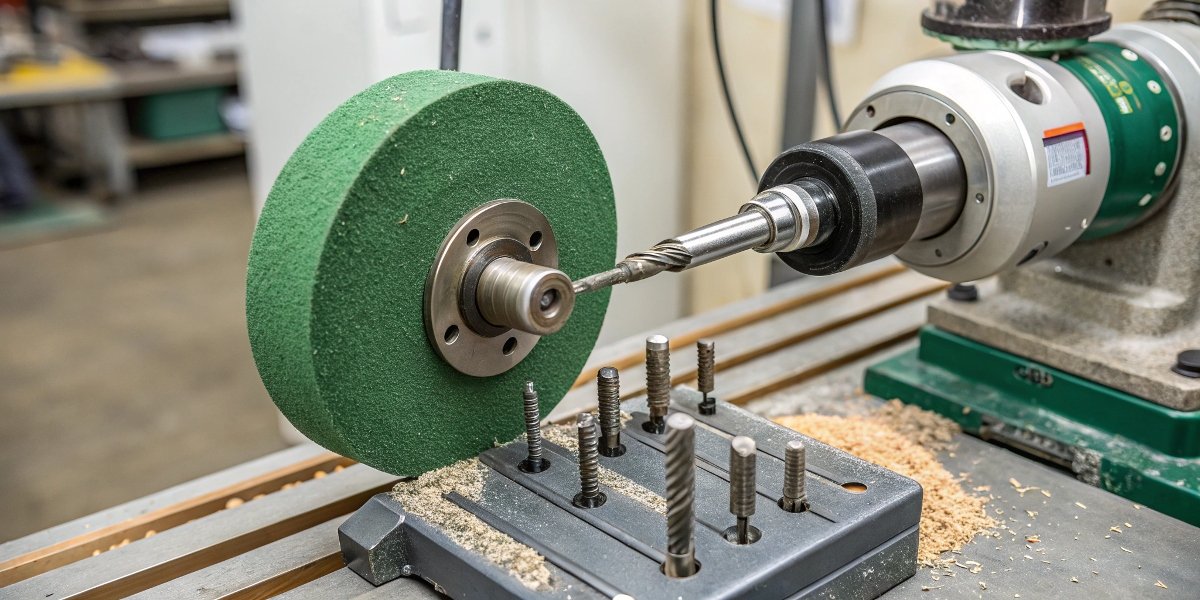
Let’s focus on the precision aspect. A green wheel isn’t for rough material removal. It is a finishing tool. Because the abrasive grains are so friable (brittle), they break away cleanly under pressure, constantly revealing fresh, sharp cutting points. This action prevents the wheel from becoming dull or "loaded." The result is a consistent cutting surface that can produce very fine finishes and hold extremely tight dimensional tolerances. This is critical in tool and die making5, where the geometry of a carbide cutter must be perfect. You’ll find green wheels in any professional toolroom for sharpening carbide-tipped saw blades, router bits, and lathe inserts. In high-tech manufacturing6, they are essential for finishing ceramic pump components or shaping optical glass. The green color is a constant reminder to the operator: this is a special tool for a special job.
What is the difference between green and black silicon carbide?
You have two silicon carbide wheels, one green and one black. They look similar, but their performance is different. Choosing the wrong one can impact your finish and how long the wheel lasts.
The primary difference is purity and toughness. Green silicon carbide is higher in purity and more brittle (friable). Black silicon carbide is slightly less pure but tougher and more durable.
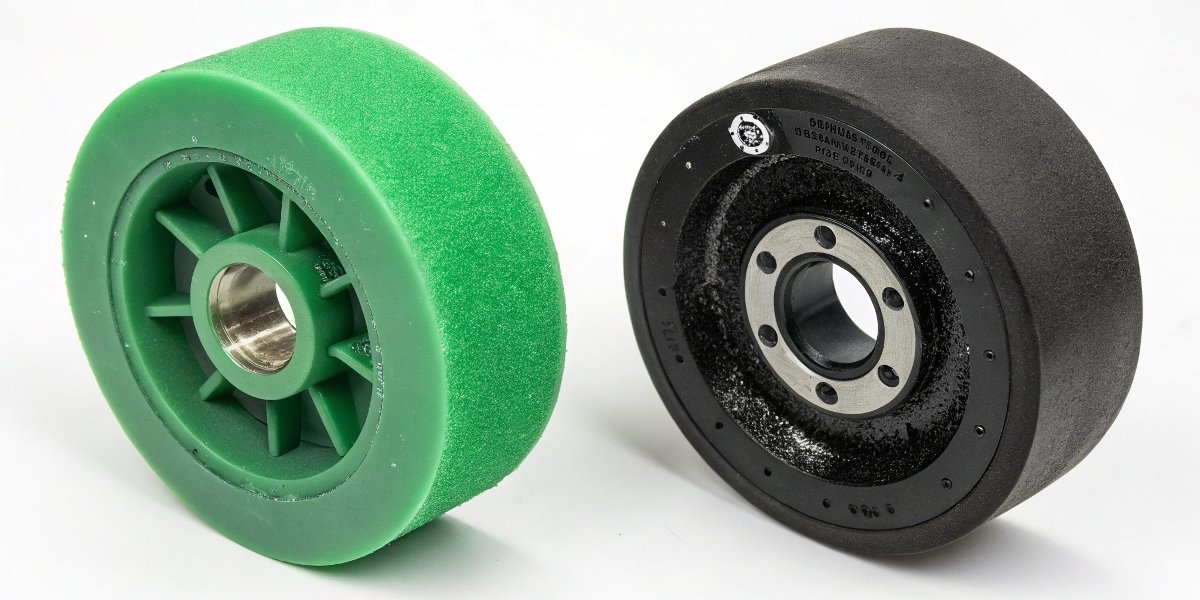
Both types start from the same raw materials, but green silicon carbide is processed to a higher level of purity. This slight difference in their chemistry has a big impact on their mechanical properties. The higher purity of green silicon carbide makes it more friable. Its grains fracture easily to create a self-sharpening effect, which is perfect for grinding the hardest materials like carbide. Black silicon carbide contains more impurities, which makes its crystal structure slightly tougher. It can absorb more impact before the grains fracture. This added toughness makes black silicon carbide7 the better choice for applications where durability is more important than ultimate sharpness. This includes grinding softer non-ferrous metals like copper or aluminum, and abrasive materials like stone, masonry, or cast iron. Think of it this way: green is for precision slicing, and black is for durable grinding.
Green (GC) vs. Black (C) Silicon Carbide
| Feature | Green Silicon Carbide (GC) | Black Silicon Carbide (C) |
|---|---|---|
| Purity | Over 99% | Around 98.5% |
| Hardness | Extremely Hard | Very Hard |
| Toughness | Low (More Friable/Brittle) | Higher (More Durable) |
| Best For | Tungsten Carbide, Ceramics, Glass | Cast Iron, Stone, Softer Non-Ferrous Metals |
Conclusion
Green silicon carbide wheels are high-purity, specialized tools for precision grinding of hard, brittle materials like carbide. Their color signals their purpose, and their friable nature ensures a sharp, clean cut.
-
This resource provides an overview of various abrasive products and their uses in manufacturing. ↩
-
Understanding friability is crucial for selecting the right abrasive; this link explains its importance in grinding. ↩
-
Learn why aluminum oxide is the go-to abrasive for steel grinding and its advantages over silicon carbide. ↩
-
Discover the applications and benefits of CBN in grinding hardened tool steels. ↩
-
Discover the importance of tool and die making in manufacturing and how precision grinding plays a role. ↩
-
Explore the challenges and innovations in high-tech manufacturing, including the role of precision tools. ↩
-
Learn about the differences between green and black silicon carbide and their respective applications. ↩
Written by
leeon
You may also be interested in:

What's the application of CBN Wheels?
Struggling with grinding hard steels? Frequent wheel changes and poor finishes can hurt your bottom line. We have found that CBN wheels provide the durability
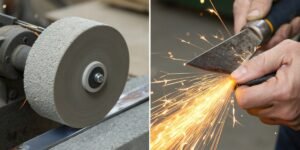
What is the difference between grinding and honing a blade?
A dull blade is a frustrating problem. It slows down production and ruins your workpiece. Using the wrong technique to fix it can cause permanent
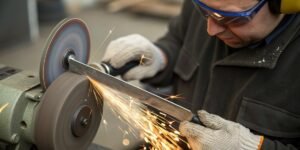
How to sharpen a knife on a bench grinder?
Is your dull knife slowing you down? A bench grinder seems like a quick fix, but you’re worried about ruining the blade. You need a

Can you use an angle grinder as a sander?
Your sanding project is tough, and your regular sander is not powerful enough. You look at your angle grinder. It has the power, but is
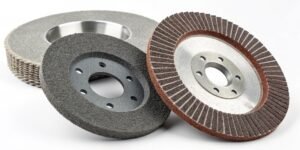
How to judge the quality of a grinding wheel?
Choosing the wrong wheel wastes money and ruins parts. Poor quality leads to downtime and rejection. A few key checks can guarantee you pick the

What is low stress grinding?
Struggling with parts failing due to hidden stress from grinding? This common issue causes cracks and reduces component life, costing you money. Low stress grinding
